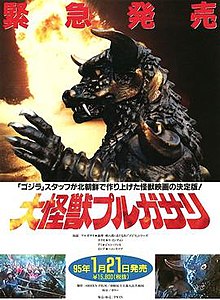This is an old revision of this page, as edited by 190.225.113.16 (talk) at 07:39, 10 June 2016. The present address (URL) is a permanent link to this revision, which may differ significantly from the current revision.
Revision as of 07:39, 10 June 2016 by 190.225.113.16 (talk)(diff) ← Previous revision | Latest revision (diff) | Newer revision → (diff)| This article needs additional citations for verification. Please help improve this article by adding citations to reliable sources. Unsourced material may be challenged and removed. Find sources: "Pulgasari" – news · newspapers · books · scholar · JSTOR (July 2015) (Learn how and when to remove this message) |
| Pulgasari | |
|---|---|
 Japanese theatrical poster Japanese theatrical poster | |
| Directed by | Shin Sang-ok Chong Gon Jo |
| Written by | Kim Se Ryun |
| Produced by | Kim Jong-il Shin Sang-ok |
| Starring | Chang Son Hui Ham Gi Sop Jong-uk Ri Gwon Ri Gyong-ae Yu |
| Cinematography | Cho Myong Hyon Pak Sung Ho Kenichi Eguchi |
| Edited by | Kim Ryon Sun |
| Music by | So Jong Gon |
| Production company | Korean Film Studio |
| Distributed by | Korean Film Studio |
| Release dates |
|
| Running time | 95 min |
| Countries | North Korea Japan |
| Language | Korean |
Pulgasari (Korean: 불가사리; RR: Bulgasari) is a 1985 North Korean monster film produced by Korean Film Studio and directed by Shin Sang-ok and Chong Gon Jo. The film starred Chang Son Hui and Pak Sung Ho and featured special effects by Duk Ho Kim, supervised by Teruyoshi Nakano. The film was loosely based on the legend of the Bulgasari. Director Shin had been kidnapped in 1978 by North Korean intelligence on the orders of Kim Jong-il, son of the then-ruling Kim Il-sung.
Kim was a lifelong admirer of the director, as well as Godzilla and other Kaiju films. He kidnapped the former director and his wife, famous actress Choi Eun-hee, with the specific purpose of making fantasy/propaganda films for the North Korean government. Kim Jong-il also produced Pulgasari and all the films that Sang-ok made before he and Choi managed to escape from their minders while on tour in Austria.
Teruyoshi Nakano and the staff from Japan's Toho studios, the creators of Godzilla, participated in creating the film's special effects.
Plot
| This section needs expansion. You can help by adding to it. (February 2016) |
In feudal Korea, during the Goryeo Dynasty, a king controls the land with an iron fist, subjecting the peasantry to misery and starvation. An old blacksmith who was sent to prison creates a tiny figurine of a monster by making a doll of rice. When it comes into contact with the blood of the blacksmith's daughter, the creature springs to life, becoming a giant metal-eating monster named Pulgasari.
The evil King becomes aware that there is a rebellion being planned in the country, which he intends to crush, but he runs into Pulgasari, who fights with the peasant army to overthrow the corrupt monarchy.
Background
The film is based around a legendary creature called the Pulgasari. The original story was set in the city of Songdo (now Kaesong, North Korea).
Legacy
Pulgasari has gained some popularity over the years because of the shocking story of Shin Sang-ok and Choi Eun-hee's kidnapping and strange captivity at the hands of North Korea's government. During their captivity they were, respectively, director and leading actress in a number of North Korean films produced by Kim Jong-il. The director and leading actress made together a total of seven films, for which the couple - who were separated before their kidnapping and eventually rekindled their romantic relationship while in captivity - was simultaneously commissioned and forced to do by North Korea's goverment. However, Pulgasari does not feature Choi, and it was the last film directed by Shin before he and Choi escaped to the United States.
Teruyoshi Nakano and the staff from Japan's Toho studios, the creators of Godzilla, participated in creating the film's special effects. Kenpachiro Satsuma – the stunt performer who played Godzilla from 1984 to 1995 – portrayed Pulgasari. When the Godzilla American remake was released in Japan in 1998, Satsuma was quoted as saying he preferred Pulgasari to the American Godzilla.
Jonathan Ross stated that the film was intended by the North Korean Government to be a propaganda metaphor for the effects of unchecked capitalism and the power of the collective.
There has been some speculation that the director Shin Sang-ok included a hidden message of his own in the film; the monster of the movie was to be interpreted as a metaphor for Kim Il-sung betraying a people's revolution for his own purposes.
See also
- Culture of North Korea
- List of North Korean films
- List of films set in or about North Korea
- Propaganda in North Korea
References
- ^ Backrow Banter, The Dear Leader, The Director And The Director’s Wife
- Choe, Sang-Hun; Torchia, Christopher (2002). "Eat, Eat: Rice Is Everything". How Koreans Talk. pp. 024–025. ISBN 89-87976-95-5.
He ate like a Bulgasari eating metal.
- First NK Monster Faces Hollywood-Born Godzilla in Japan The People's Korea
- "A KIM JONG IL PRODUCTION". New Yorker. Retrieved 8 May 2013.
- Taylor, Ben. Apocalypse on the Set: Nine Disastrous Film Productions. Overlook Hardcover. pp. 168–169. ISBN 146830013X.
- http://www.theguardian.com/film/2003/apr/04/artsfeatures1
External links
| Films directed by Shin Sang-ok | |
|---|---|
|